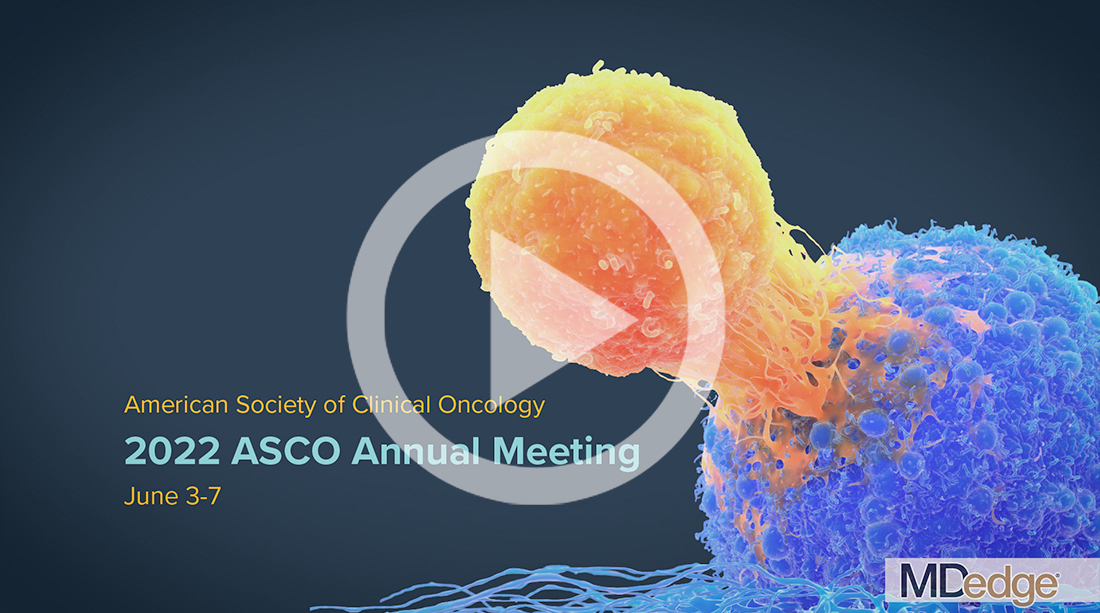User login
Dr Ann Partridge from the Dana-Farber Cancer Institute in Boston, Massachusetts, highlights important new data in early breast cancer presented at American Society of Clinical Oncology (ASCO) 2022.
Dr Partridge begins with promising results from the NeoSTAR study, which looked at the use of the novel antibody-drug conjugate (ADC) sacituzumab govitecan in the neoadjuvant setting. This is the first trial of an ADC in patients with triple-negative breast cancer (TNBC) and demonstrated single-agent efficacy in localized TNBC.
Next, Dr Partridge discusses the 8-year post-trial follow-up of the ASTRRA study, which randomly assigned patients to 5 years of tamoxifen or 5 years of tamoxifen plus 2 years of ovarian suppression. The findings demonstrated consistent survival advantage and suggest that adding ovarian function suppression to tamoxifen should be considered for those who remain in a premenopausal state or resume ovarian function after chemotherapy.
Looking to potential new biomarkers for risk recurrence, Dr Partridge reports on provocative data from the CHiRP study. The investigators looked at the use of circulating tumor DNA to identify minimal residual disease and predict clinical outcomes in high-risk, early-stage HR+ breast cancer. Although additional research is needed, Dr Partridge is encouraged that in the near future, the use of circulating DNA technology will help guide therapeutic decisions in early breast cancer.
--
Ann H. Partridge, MD, MPH, Professor of Medicine; Vice Chair of Medical Oncology, Department of Breast Oncology, Dana-Farber Cancer Institute, Boston, Massachusetts
Ann H. Partridge, MD, MPH, has disclosed no relevant financial relationships.
Dr Ann Partridge from the Dana-Farber Cancer Institute in Boston, Massachusetts, highlights important new data in early breast cancer presented at American Society of Clinical Oncology (ASCO) 2022.
Dr Partridge begins with promising results from the NeoSTAR study, which looked at the use of the novel antibody-drug conjugate (ADC) sacituzumab govitecan in the neoadjuvant setting. This is the first trial of an ADC in patients with triple-negative breast cancer (TNBC) and demonstrated single-agent efficacy in localized TNBC.
Next, Dr Partridge discusses the 8-year post-trial follow-up of the ASTRRA study, which randomly assigned patients to 5 years of tamoxifen or 5 years of tamoxifen plus 2 years of ovarian suppression. The findings demonstrated consistent survival advantage and suggest that adding ovarian function suppression to tamoxifen should be considered for those who remain in a premenopausal state or resume ovarian function after chemotherapy.
Looking to potential new biomarkers for risk recurrence, Dr Partridge reports on provocative data from the CHiRP study. The investigators looked at the use of circulating tumor DNA to identify minimal residual disease and predict clinical outcomes in high-risk, early-stage HR+ breast cancer. Although additional research is needed, Dr Partridge is encouraged that in the near future, the use of circulating DNA technology will help guide therapeutic decisions in early breast cancer.
--
Ann H. Partridge, MD, MPH, Professor of Medicine; Vice Chair of Medical Oncology, Department of Breast Oncology, Dana-Farber Cancer Institute, Boston, Massachusetts
Ann H. Partridge, MD, MPH, has disclosed no relevant financial relationships.
Dr Ann Partridge from the Dana-Farber Cancer Institute in Boston, Massachusetts, highlights important new data in early breast cancer presented at American Society of Clinical Oncology (ASCO) 2022.
Dr Partridge begins with promising results from the NeoSTAR study, which looked at the use of the novel antibody-drug conjugate (ADC) sacituzumab govitecan in the neoadjuvant setting. This is the first trial of an ADC in patients with triple-negative breast cancer (TNBC) and demonstrated single-agent efficacy in localized TNBC.
Next, Dr Partridge discusses the 8-year post-trial follow-up of the ASTRRA study, which randomly assigned patients to 5 years of tamoxifen or 5 years of tamoxifen plus 2 years of ovarian suppression. The findings demonstrated consistent survival advantage and suggest that adding ovarian function suppression to tamoxifen should be considered for those who remain in a premenopausal state or resume ovarian function after chemotherapy.
Looking to potential new biomarkers for risk recurrence, Dr Partridge reports on provocative data from the CHiRP study. The investigators looked at the use of circulating tumor DNA to identify minimal residual disease and predict clinical outcomes in high-risk, early-stage HR+ breast cancer. Although additional research is needed, Dr Partridge is encouraged that in the near future, the use of circulating DNA technology will help guide therapeutic decisions in early breast cancer.
--
Ann H. Partridge, MD, MPH, Professor of Medicine; Vice Chair of Medical Oncology, Department of Breast Oncology, Dana-Farber Cancer Institute, Boston, Massachusetts
Ann H. Partridge, MD, MPH, has disclosed no relevant financial relationships.
